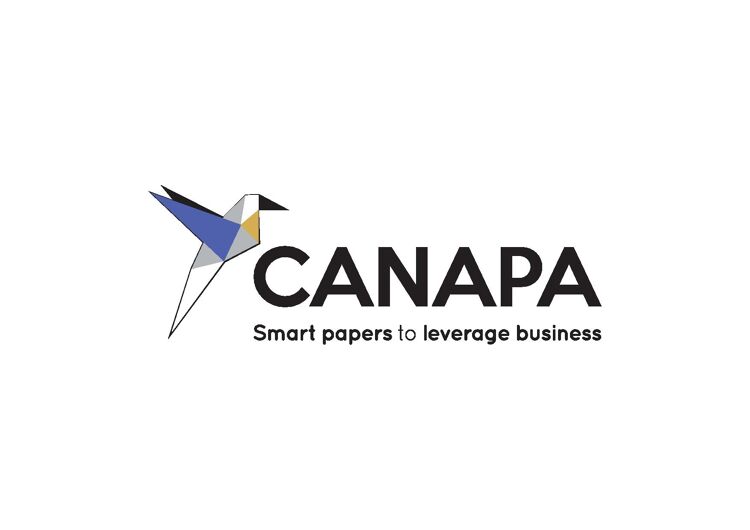CANAPA Paper Technologies will exhibit at FESPA 2019 with its smart sublimation papers

CANAPA Paper technologies will meet its visitors with the sublimation paper range it has developed according to needs of textile manufacturer at the Global Print Expo 2019.
The Global Print Expo 2019 will host visitors from around the world. Aiming to respond to high quality sublimation paper needs of textile print manufacturers who visit the fair, CANAPA Paper Technologies will host its visitors this year at stand D18 in Hall B6.
CANAPA this year will meet its visitors with a brand new identity
“Nature” expression used in CANAPA’s new identity has two different meanings. While it represents authenticity that comes from nature of paper, creative power, quality obtained and being unique; on the other hand it is also emphasizing CANAPA’s environment friendly manufacturing. CANAPA sublimation papers are manufactured with a raw material acquired from industrial trees grown in Scandinavian region. Paper raw materials, obtained from these forests only grown for industrial means and not harming the natural ecosystem, and also the transfer paper raw material is continuously obtained from the same forest. This way, CANAPA sublimation transfer papers always maintain the same quality. This enables the textile print manufacturer to obtain the same print quality in all its productions and attain a standard and stable print quality.
Meet the CANAPA Ventus and Vivus series
What do CANAPA sublimation papers offer to textile print manufacturers?
The biggest advantage of CANAPA sublimation papers that comes forth is its stronger paper base structure compared to many of its equivalents in the market, its stable print quality and its double layer coating technology. Tests done by R&D engineers prove that CANAPA transfer papers have stronger paper base features regarding measurement criteria such as bursting strength, bursting index, breaking strength and bending resistance compared to known European, Korean and Chinese brands. Moreover, CANAPA base papers having less additives show that it has a more pure paper structure and thus rate of variance in paper quality is much less.
Strong structural features of the base paper of CANAPA transfer papers correlate closely with the raw materials used in manufacturing of CANAPA transfer papers and their manufacturing process. CANAPA sublimation transfer papers are manufactured from bleached pure cellulose and contain entirely prime fibers. Obtaining of these fibers from slowly grown Scandinavian forests come forth as primary component that strengthens the structure of the base paper used in manufacturing of CANAPA transfer papers.
The most important of the many advantages all the features provide is its elimination of the problems faced during printing. Today, one of the most significant problems faced during printing is the wrinkling problem caused due to transfer paper not having a strong structure to carry sufficient amount of ink. The biggest problem the transfer paper which coils up because it cannot carry the ink is head collisions. This causes colliding head to leave a mark on the print and even worse, technical malfunctions which may require full replacement of print heads which cost thousands of dollars and also loss of time.
One of the biggest advantages of CANAPA sublimation transfer papers is also ensuring these printing machines to function on designs where the most dense ink consumption is needed without facing any problems. Dense ink carrying ability of strong base paper structure of CANAPA transfer papers prevent head collisions, thus; prevent material waste and therefore increase production capacity.
FESPA Global Print Expo 2019 is Europe’s largest speciality print exhibition for screen and digital wide format print, textile printing and signage solutions. Visit CANAPA at stand D18 in Hall B6at the Messe Munich between the 14-17 May 2019 and discover the available features. Please use promo code FESG902 to register for free.
Topics
Interested in joining our community?
Enquire today about joining your local FESPA Association or FESPA Direct
Recent news

The importance of ink for large format printers
Ink is crucial for large format inkjet printers, influencing substrate compatibility, productivity, and cost. Nessan Cleary discusses the three main types which include UV-curable ink, latex ink and eco-solvent ink. Each ink type has specific strengths and weaknesses, making printers choice dependent on budget and intended applications.

What are the benefits of Direct-To-Fabric printing?
Direct-to-fabric printing is gaining popularity for high-volume textile production, enabling on-demand, customized short runs. These printers offer ink flexibility, accommodating various fabric types like cotton and silk, though ink development focuses on faster turnaround by reducing pre- and post-processing. Compared to traditional methods, direct-to-fabric inkjet printing is a more sustainable option due to reduced water and chemical usage, and localized production.

What are the opportunities for large format providers regarding digital touch screens?
Digital touchscreens are becoming increasingly common, offering businesses opportunities to improve customer engagement and streamline operations. Nessan Cleary shares, while more expensive to implement than standard digital displays due to complex software and integration needs, touchscreens provide self-service options, multilingual support, and can reduce staffing costs in various settings like retail, transportation, and healthcare.
